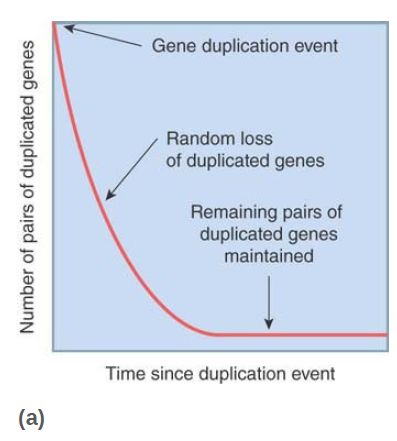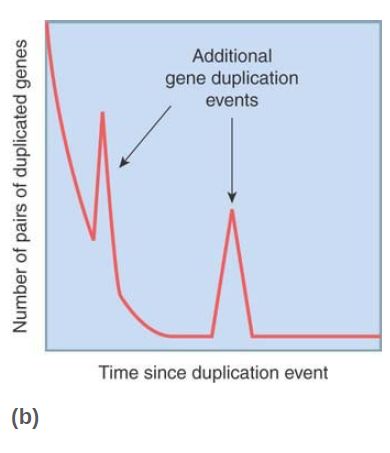


 النبات
النبات
 الحيوان
الحيوان
 الأحياء المجهرية
الأحياء المجهرية
 علم الأمراض
علم الأمراض
 التقانة الإحيائية
التقانة الإحيائية
 التقنية الحيوية المكروبية
التقنية الحيوية المكروبية
 التقنية الحياتية النانوية
التقنية الحياتية النانوية
 علم الأجنة
علم الأجنة
 الأحياء الجزيئي
الأحياء الجزيئي
 علم وظائف الأعضاء
علم وظائف الأعضاء
 الغدد
الغدد
 المضادات الحيوية
المضادات الحيوية| Genome Duplication Has Played a Role in Plant and Vertebrate Evolution |
|
|
|
Read More
Date: 14-11-2020
Date: 12-6-2021
Date:
|
Genome Duplication Has Played a Role in Plant and Vertebrate Evolution
KEY CONCEPTS
-Genome duplication occurs when polyploidization increases the chromosome number by a multiple of two.
-Genome duplication events can be obscured by the evolution and/or loss of duplicates as well as by chromosome rearrangements.
-Genome duplication has been detected in the evolutionary history of many flowering plants and of vertebrate animals.
As discussed in the section Gene Duplication Contributes to Genome Evolution earlier in this chapter, genomes can evolve by duplication and divergence of individual genes or of chromosomal segments carrying blocks of genes. However, it appears that some of the major metazoan lineages have had genome duplications in their evolutionary histories. Genome duplication is accomplished by polyploidization, as when a tetraploid (4n) variety arises from a
diploid (2n) ancestral lineage.
There are two major mechanisms of polyploidization. Autopolyploidy occurs when a species endogenously gives rise to a polyploid variety; this usually involves fertilization by unreduced
gametes. Allopolyploidy is a result of hybridization between two reproductively compatible species such that diploid sets of chromosomes from both parental species are retained in the hybrid offspring. As with autopolyploids, the process generally involves the accidental production of unreduced gametes. In both cases, new tetraploids are usually reproductively isolated from the diploid parental species because backcrossed hybrids are triploid and sterile, as some chromosomes are without homologs during meiosis.
Following the successful establishment of a polyploidy species, many mutations can be essentially neutral. As with gene duplications, nonsynonymous substitutions are “covered” by the redundant functional copy of the same gene. In the case of a genome duplication, the deletion of a gene or chromosomal segment or the loss of a chromosome pair might have little
phenotypic effect. In addition to the loss of chromosomal segments, chromosomal rearrangements such as inversions and translocations will shuffle the locations and orders of blocks of genes. Over a long period of time, such events can obscure ancestral polyploidization. However, there might still be evidence of polyploidization in the presence of redundant chromosomes or chromosomal segments within a genome.
One successful approach to detecting ancient polyploidization is to compare many pairs of paralogous (duplicated) genes within a species and establish an age distribution of gene duplication events. Many events of approximately the same age can be taken as evidence of polyploidization. As seen in FIGURE 1, genome duplication events will appear as peaks above the general pattern of random events of gene duplication and copy loss. This approach, along with an analysis of chromosomal locations of gene duplications, suggests that the evolutionary histories of the unicellular yeast S. cerevisiae and many flowering plants include one or more genome duplication events. The genetic model of the land plant Arabidopsis thaliana, for example, has a history of two, or possibly three, polyploidization events.


FIGURE 1 (a) A constant rate of gene duplication and loss shows an exponentially decreasing age distribution of duplicated gene pairs. (b) A genome duplication event shows a secondary peak in the age distribution as many genes are duplicated at the same time.
Data from: Blanc, G. and Wolfe, K. H. 2004. Plant Cell 16:1667–1678.
Because polyploidization is more common in plants than in animals, it is not surprising that most detected examples of genome duplication are in plant species. However, genome duplication appears to have played an important role in vertebrate evolution, specifically in ray-finned fishes. As evidence, the zebrafish genome contains seven Hox clusters as compared to four clusters in tetrapod genomes, suggesting that there was a tetraploidization event followed by secondary loss of one cluster. The analysis of other fish genomes suggests that this event occurred before the diversification of this taxonomic group. The presence of four Hox clusters in tetrapods (and at least four in other vertebrates), together with the observation of other shared gene duplications as compared to invertebrate animal genomes, itself suggests that
there might have been two major polyploidization events prior to the evolution of vertebrates. In reference to “two rounds of polyploidization,” this has been termed the 2R hypothesis.
This hypothesis leads to the prediction that many vertebrate genes, like the Hox clusters, will be found in four times the copy number as compared to their orthologs in invertebrate species. The subsequent observation that less than 5% of vertebrate genes show this 4:1 ratio seems weak support for the hypothesis at best.
However, it is to be expected that after nearly 500 million years of evolution, many of the additional copies of genes would have been deleted, evolved significantly to take on new functions, or become pseudogenes and decayed beyond recognition. Stronger support, however, comes from analyses that take into account the map position of duplications that date to the time of the common ancestor of vertebrates. The ancient gene duplications that do show the 4:1 pattern tend to be found in clusters, even after a halfbillion years of chromosomal rearrangements. The vertebrates evidently began their evolutionary history as octoploids. The 2R hypothesis is tempting as an explanation for the burst of morphological complexity that accompanied the evolution of vertebrates, although as yet there is little evidence of a direct correlation between the genomic and morphological changes in this taxonomic group.



|
|
|
|
كيف تعزز نمو الشعر الصحي؟
|
|
|
|
|
|
|
10 فحوصات مهمة يجب القيام بها لسيارتك قبل الصيف
|
|
|
|
|
|
العتبة العباسية تختتم فعاليات حفل التكليف الشرعي في قضاء عين التمر بكربلاء
|
|
|
|
طالبات مدارس عين التمر يرددن نشيد التكليف الشرعي
|
|
|
|
الطالبات المشاركات في حفل التكليف الشرعي يقدمن الشكر للعتبة العباسية
|
|
|
|
حفل التكليف الشرعي للطالبات يشهد عرض فيلم تعريفي بمشروع (الورود الفاطمية)
|